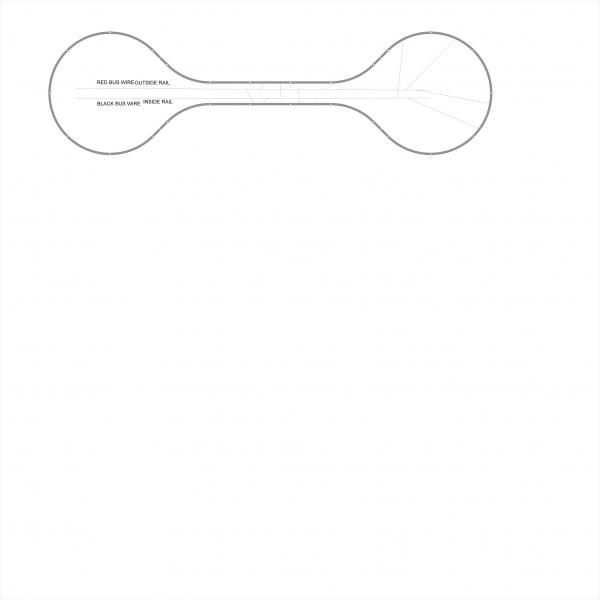Any Electricians out there.
Posted
#121217
(In Topic #6331)
Full Member
What size wire should be used for bus wires ?
Hi Guys,I am getting back to Y.M.R. and the time has come to put in the bus wires and droppers.
What size wire should I use for the bus wires and droppers.
I have some single core 3 m.m. and 6 m.m. and am not sure which to use where.
John.
Posted
Guest user
Perhaps haveing a read of this may help
DCC Layout Wire & Wiring Accessories
Posted
Inactive Member
Strip out the black, red and green from the white covering on the 2.5 service cable. The red bus is the outside rail and the black is the inside rail. The droppers should be the same and when you're underneath you can't make a mistake.
Speaking of that, connect a buzzer across the rails after disconnecting your DCC system. If the buzzer goes off while you are connecting up your droppers, you've made a mistake. You will never have to look for shorts in the future.
The green will come in handy for a sub-bus when you start to put in block detectors.
I don't know how good your soldering is, but I have done a thread on soldering in the droppers underneath using half of the covering on the bus wire. It's a piece of cake.
Max
Port Elderley
Port Elderley
Posted
Full Member
I will have to go and get some more cable.
Will keep you posted on results over the next few weeks.
Cheers.
John.
Posted
Full Member
The real I Like trains kid !
Posted
Inactive Member
Under no circumstances make your bus into a circle. A straight line, a TEE, a Wyee; but NEVER a circle. Putting snubbers on the end is a good idea, as well.
Like I said, you probably already knew that, but I just thought I'd mention it. :pedal
Max
Port Elderley
Port Elderley
Posted
Legacy Member
reg
Posted
Inactive Member
A similar rule seems to apply to the express net bus - in addition, manufacturers recommend twisting the wires in the net bus, as well as not connecting them into a loop. I've never heard of using snubbers on the express net bus.
Whatever the reason, loops have been found to be the offenders where locos have been behaving erratically, but not always on the same spot on the layout. It makes sense that it seems to be on the bigger layouts that it's more noticable. I hope that makes sense in a not too technical way. I'm sure Geoff will explain it better when he reads this.
Max
Port Elderley
Port Elderley
Posted
Full Member
It,s basically a dog bone with the straigt sections close together to look like dual track so I can run the bus down the middle and just have longer droppers from the two ends.
Hope that makes sense.
Will now redesign it.
Cheers.
 Last edit: by AUSSIETRAINS
Last edit: by AUSSIETRAINS
John.
Posted
Full Member

Hope you can make it out Max.
Edit.
As picture seems a bit small.
All droppers from the outside rail connect to the RED BUS.
All droppers from the inside rail connect to the BLACK BUS.
 Last edit: by AUSSIETRAINS
Last edit: by AUSSIETRAINS
John.
Posted
Guest user
The loop/circle of power works, just that the larger layouts are prone to problems at times as Max mentioned.
Snubbers/terminators are only used on power bus, not control/express net bus.
Can I suggest you read this site?
http://www.wiringfordcc.com/track_2.htm#a52
starting a third of the way down titled
Considerations for Layouts with Long Bus Wires
Posted
Inactive Member
You might find that the picture can be improved by right clicking on it then, Edit > Brightness/Contrast > Crop.
From what I can see It looks OK. As a rule of thumb, take the two bus wires around the layout under the main track, so long as you don't close the loops. It will help later if you want to put in block detectors for signalling and the like. Keep the droppers as short as practicable.
Max
Port Elderley
Port Elderley
Posted
Legacy Member
reg
Posted
Inactive Member
Max
Port Elderley
Port Elderley
Posted
Guest user
Reg, don't forget that your rails may also make a ring so be prepared to cut them & put isolators in as well.Thanks for that Max. Everything has run ok up to now . Well i say that, i have had the odd rogue loco ,i have always put it down to spurious radiation (dont know what that means but i heard of it somewhere.) At worst i will have to put the sidecutters on the ring about half way round. :thumbs. Thanks for the info .
Posted
Legacy Member
reg
Posted
Full Member
John.
Posted
Guest user
There are so many variables with DCC, that one answer may not be suitable for another layout but in general, if breaks can be included early, it may save problems later on.
Posted
Inactive Member
Ken
'It don't mean a thing if it ain't got that Swing'
Posted
Legacy Member
Bozzy(never known to pass a pub)
1 guest and 0 members have just viewed this.

